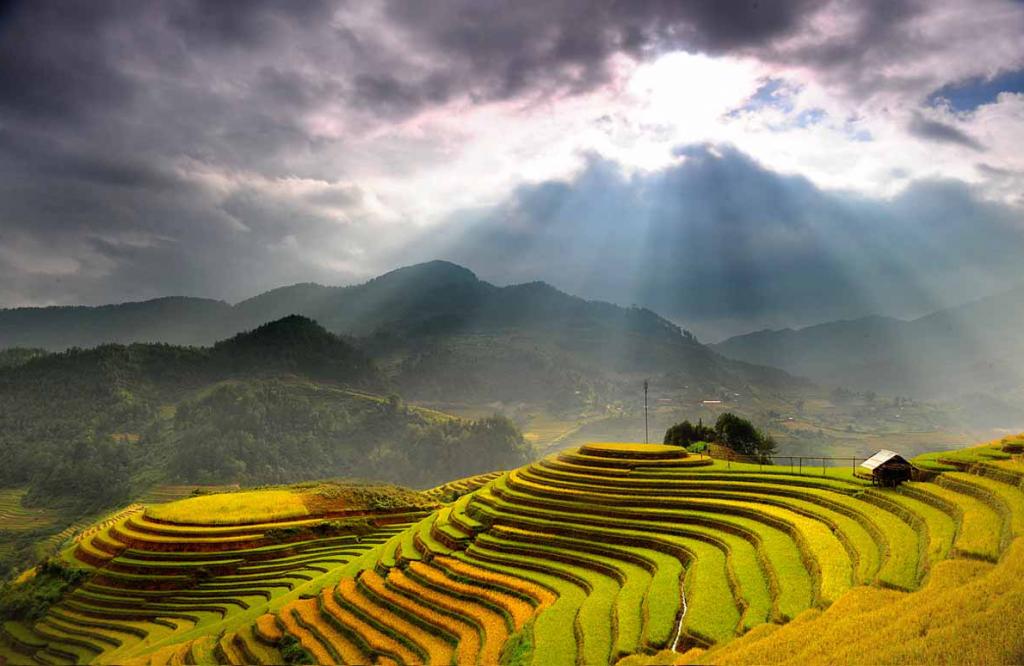Sapa in detail
Sapa is oriented to make the most of the spectacular views emerging on clear days; it overlooks a plunging valley, with mountains towering above on all sides. Views are often subdued by thick mist rolling across the peaks, but even when it’s cloudy, local hill-tribe people fill the town with colour.
If you were expecting a quaint alpine town, recalibrate your expectations. Modern tourism development has mushroomed haphazardly. Thanks to rarely enforced building-height restrictions, Sapa’s skyline is continually thrusting upwards.
But you’re not here to hang out in town. This is northern Vietnam’s premier trekking base, from where hikers launch themselves into a surrounding countryside of cascading rice terraces and tiny hill-tribe villages that seem a world apart. Once you’ve stepped out into the lush fields, you’ll understand the Sapa area’s real charm
Table of Contents
1. Activities
Hiking
You won’t step too far out of your hotel in Sapa before being accosted with offers to guide you on hikes.
For longer treks with overnight stays in villages, it’s important to hook up with someone who knows the terrain and culture and speaks the language. We recommend using minority guides, as this offers them a means of making a living. Note it’s illegal to stay overnight in villages that are not officially recognised as homestays. Ignoring this could cause significant problems for your hosts and yourself. Always go through a reputable tour agency and be sure to ask how legitimate they are.

The surrounding landscape is now part of Hoang Lien National Park (Tonkinese Alps) and all the villages that can be visited have admission fees from 20,000d to 40,000d. Most treks will take you through extremely muddy, slippery surfaces, especially after rain. Gumboots are recommended and guides can suggest stores to buy or rent protective footwear for US$2 to US$4.
2. Sleeping
Many hotels raise rates on Fridays and Saturdays with the weekend influx of domestic tourists.
Sapa can be busy, so if there’s somewhere in particular you want to stay, prebook directly with the hotel itself for a better rate.
2.1 In Town
Construction, touts and tourists mean that staying in Sapa itself can be a hectic experience, and we advise visitors to stay outside of the city centre. That said, if you want to be close to the action, there’s some excellent-value places to stay.
2.2 Outside of Town
To experience what Sapa really offers, it’s necessary to stay outside of the city centre. Go only a few kilometres out of town, and the landscape is mountainous, beautiful and rural, and is also home to the area’s most unique accommodation options.
3. Eating
There are plentiful restaurants along P Cau May serving identikit menus of Vietnamese and Western staples. Look out for hill-tribe specialities using Sapa’s wild mushrooms and herbs, and local fish.
For eating on a budget, humble Vietnamese restaurants huddle on Ð Tue Tinh, and the stalls south of the church can’t be beaten for bun cha (barbecued pork).
4. Drinking & Nightlife
A bar crawl in Sapa will take in a maximum of five or so venues – this is not a party town
5. Shopping
Lots of the minority women and girls have gone into the souvenir business; and Sapa’s streets are packed with handicraft peddlers. The older women in particular are canny traders and known for their strong-arm selling tactics. When negotiating prices, hold your ground, but avoid aggressive bargaining.
Note that on some cheaper textiles, the dyes used are not set, which can turn anything the material touches (including your skin) a muddy blue-green colour. Wash the fabric separately in cold salted water to stop the dye from running, and wrap items in plastic bags before packing them in your luggage.
If you’ve arrived in town with insufficient warm clothing, stores along P Cau May sell lots of ‘brand-name’ walking shoes, parkas and thermals. Some of it might even be authentic, but don’t count on it; haggle accordingly.
6. Getting Around
The best way to get around compact Sapa is to walk. Bicycles can be hired, but you’ll spend half your time pushing it up steep hills.
For excursions, motorbikes are available from about US$5 a day. If you’ve never ridden a motorbike before, this is not the place to learn. The weather can be wet and treacherous at any time of the year, and roads are steep and regularly damaged by floods and heavy rain.
Consider hiring a xe om. Local drivers hang out on the corner of P May Cai and Ɖ Phan Si. Some sample prices: one way/return to Cat Cat 40,000/70,000d; Sin Chai 60,000/100,000d; Ta Van 80,000/120,000d; and Thac Bac (Silver Waterfall) 70,000/120,000d.



